On Friday evening, we witnessed the first game of the new Premier League season with new boys Brentford facing Mikel Arteta’s Arsenal. What occurred was an impressive showing from The Bees which saw them prevail over one of the league’s ‘Big Six’. This tactical analysis will take a look at the tactics of both sides and how it ended in three points for Brentford.
Lineups
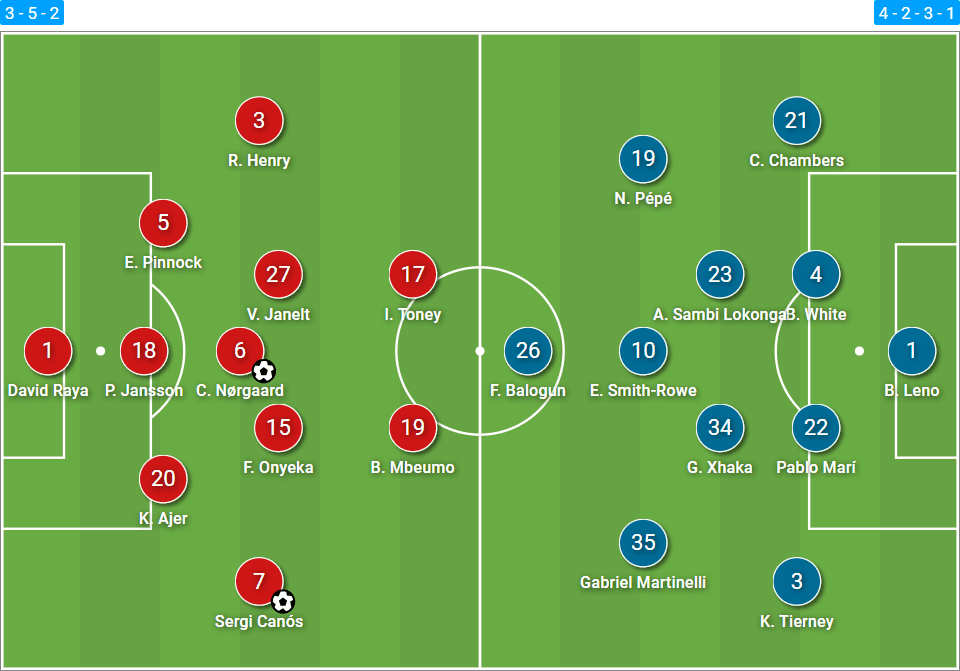
Brentford (3-5-2): David Raya; Kristoffer Ajer, Pontus Jansson, Ethan Pinnock; Sergi Canós, Frank Onyeka, Christian Nørgaard, Vitaly Janelt, Rico Henry; Ivan Toney, Bryan Mbeumo.
In their first-ever Premier League appearance, Thomas Frank went with the system that suited Brentford very nicely during the Championship run-in last season, a sort-of 3-5-2 which can be seen as a 5-3-2, 3-1-4-2, or 3-4-1-2 at different moments. Rico Henry was a welcome return in that left wing-back role, and a couple of new signings, former Celtic defender Kristoffer Ajer and Frank Onyeka made their official debuts.
Arsenal (4-2-3-1): Bernd Leno; Callum Chambers, Ben White, Pablo Marí, Kieran Tierney; Albert Sambi Lokonga, Granit Xhaka; Nicolas Pépé, Emile Smith Rowe, Gabriel Martinelli; Florian Balogun.
Mikel Arteta, on the other hand, stuck with his 4-2-3-1 system that provided mixed success last season. Owing to injury and transfer rumour reasons, the likes of Pierre-Emerick Aubameyang, Alexandre Lacazette, and Héctor Bellerín were all absent from this fixture, giving Callum Chambers, Gabriel Martinelli, and Florian Balogun a chance to show what they’ve got. Albert Sambi Lokonga and Ben White made their official debuts in this match too.
Brentford’s targeted pressing & Arsenal’s response
Arteta’s continued emphasis on building out from the back with these defenders at his disposal was almost punished on a few occasions in this game. Leno is not quite the sweeper-keeper that Arteta seemingly thinks he is, and while the German is willing to build out from the back, his ability and composure under pressure lets him down. In his area of the pitch, this simply cannot happen. He and Marí had a couple of moments where they lacked synergy, causing panic.
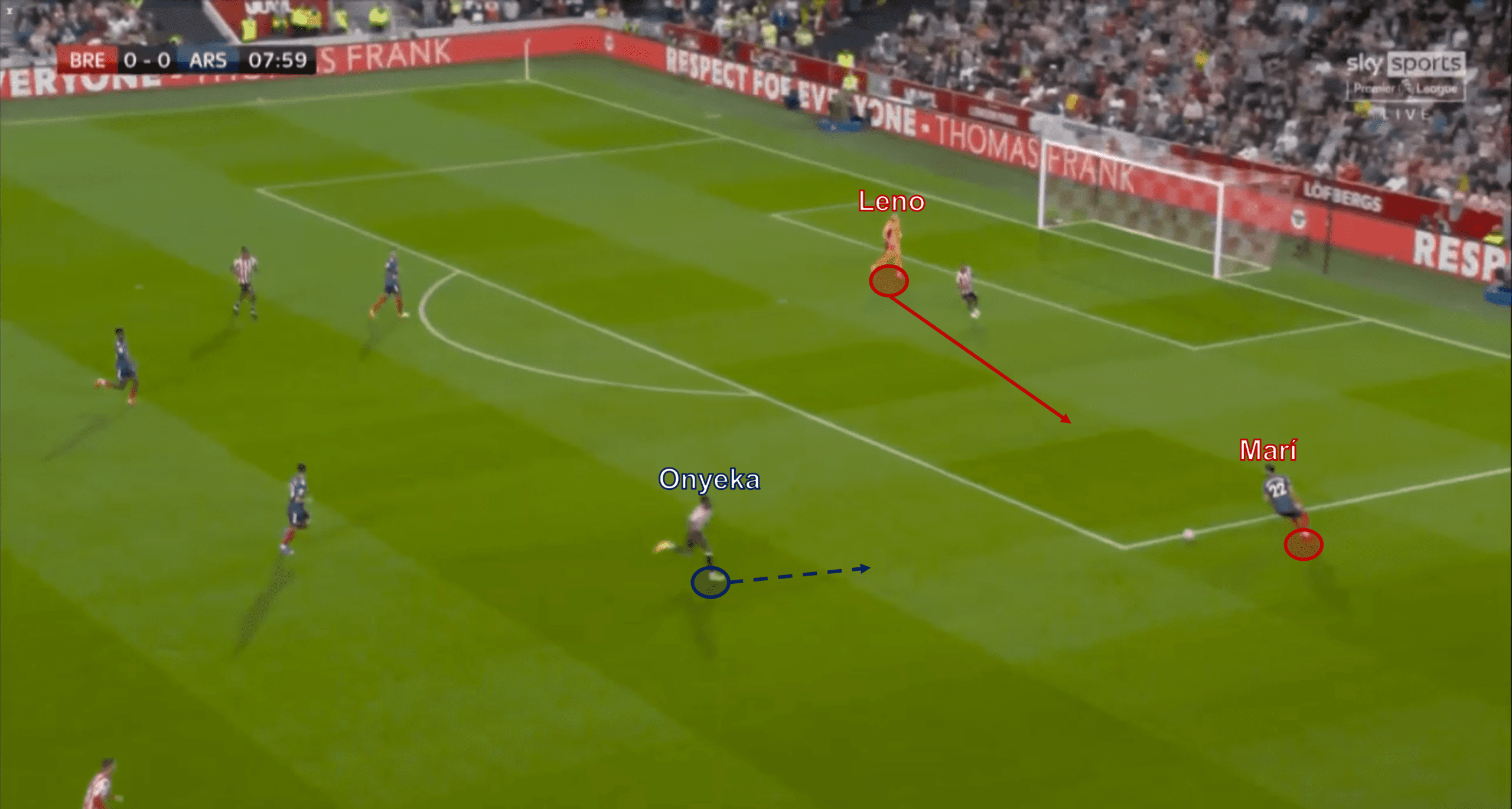
Leno overhits his pass to the Spanish centre-back, and as a result, a heavy touch is taken, encouraging Onyeka to increase his pressing energy.
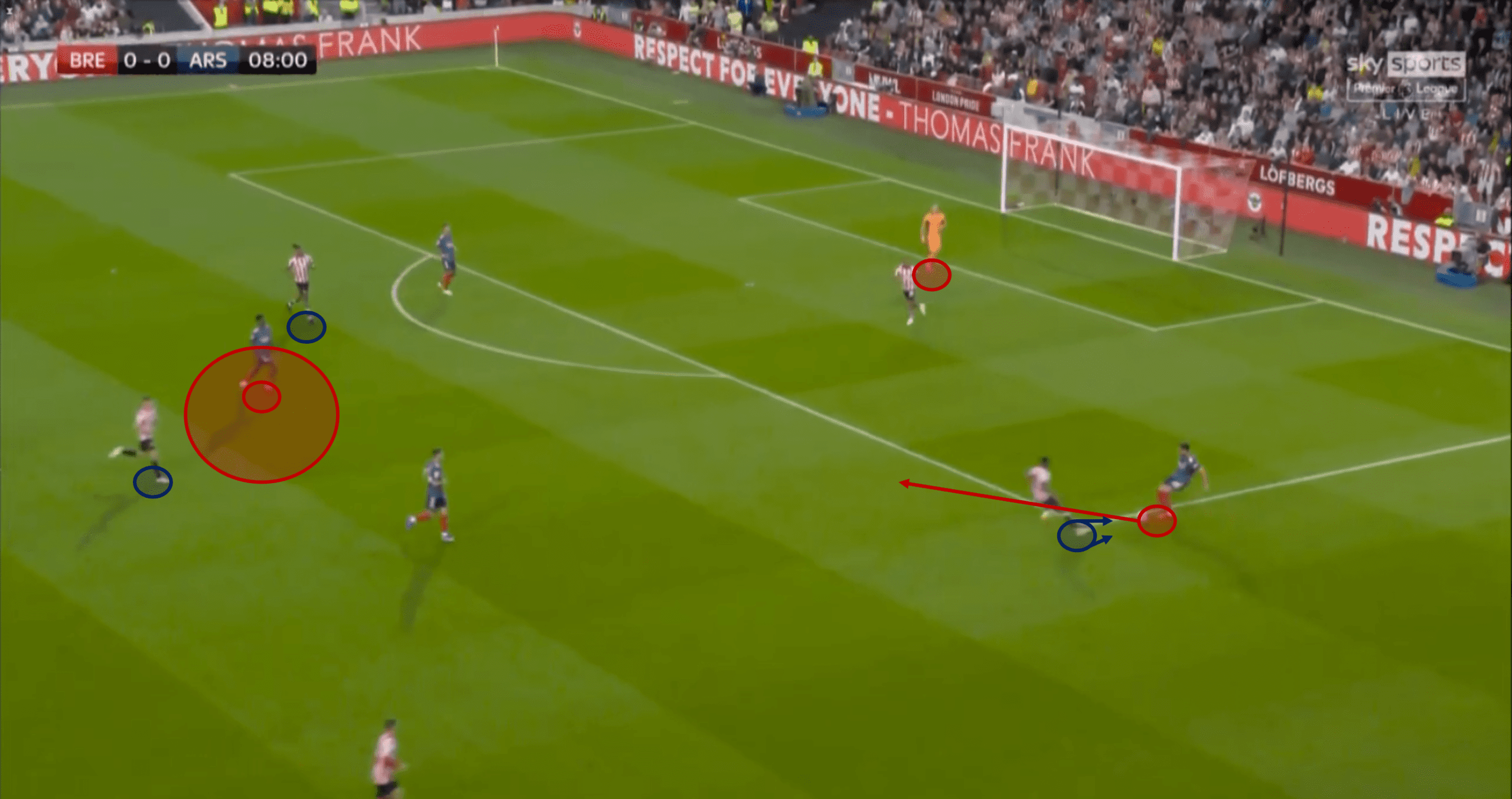
Eventually, the pass is played to Lokonga in midfield, who is in a compromised position himself with two Brentford players either side of him.
Early signs for Arsenal in the backline were that Marí if placed under pressure, could be had in this game. Brentford knew this pre-match, however, and consistently made him the target of their united pressing. Marí took a few bad touches in the game that Brentford looked to make the most of, but whenever the Spanish centre-back picked up the ball in a wider area, the Brentford attackers would zone in on his position.
Frank’s side employed a fairly high press whenever Arsenal had possession of the ball in their own third, and in these moments, Brentford would only give the Arsenal defenders a small amount of time on the ball before they would be dispossessed. However, Brentford’s system also made it easy to switch to a back five whenever Arsenal approached their defensive third, which enabled Brentford to pack the area with Nørgaard dropping deep to offer cover and the opposite wing-back also marking inside the area.
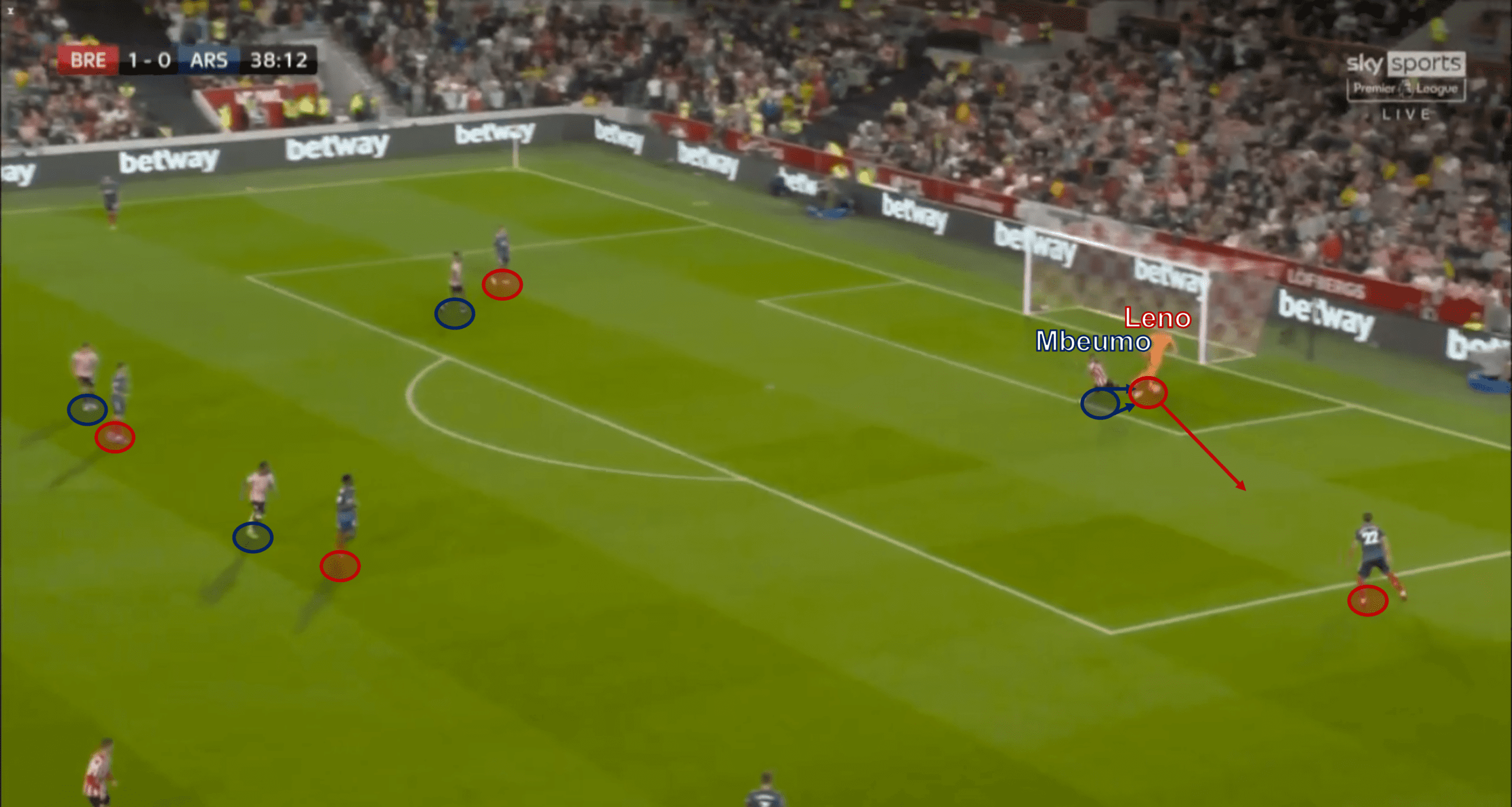
Here is just one example of Mbeumo going all the way with his pressing, almost dispossessing keeper Leno.
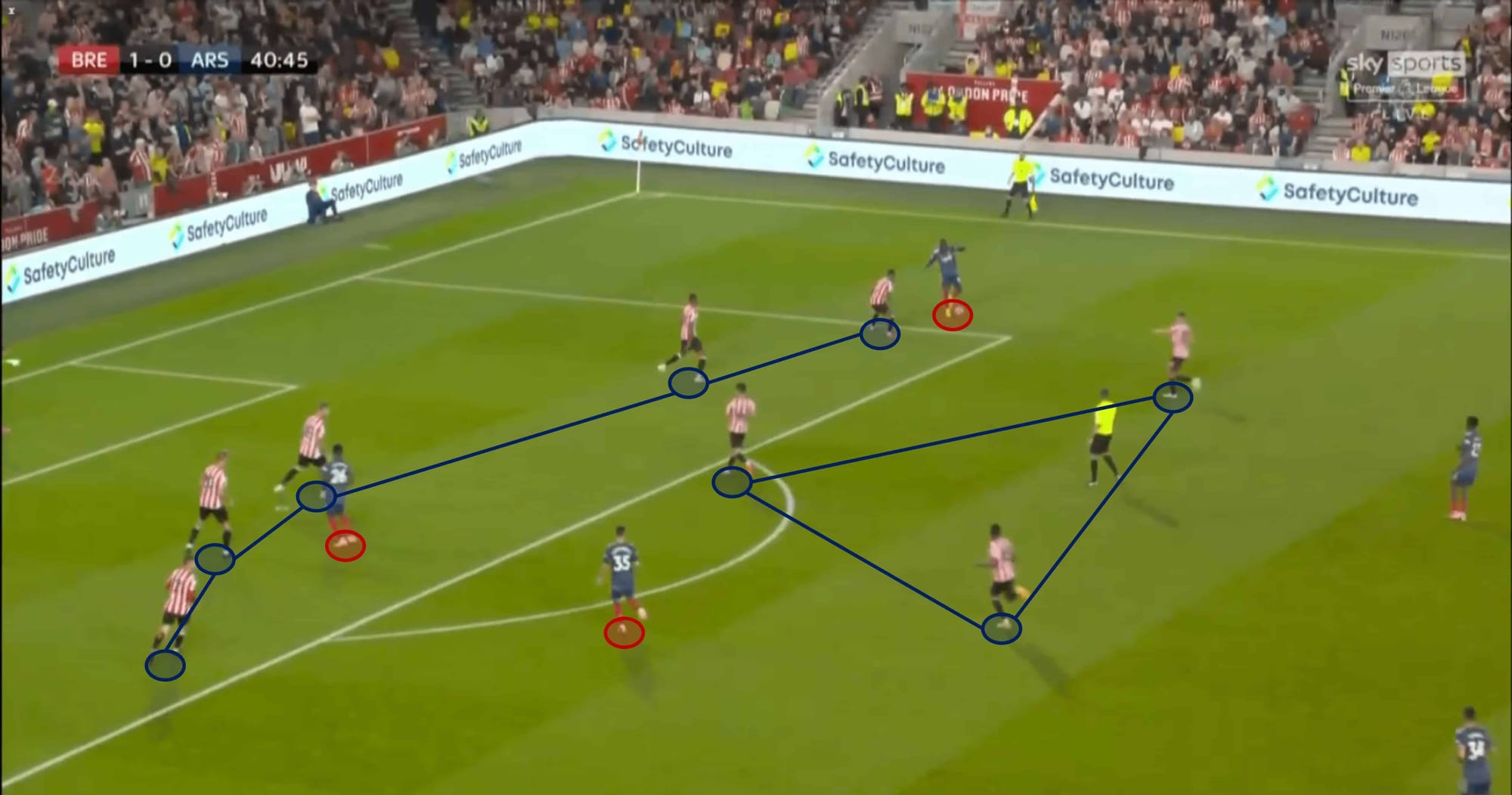
Although we see when Arsenal attacked, Brentford were quick enough to react, restructure themselves and pack the penalty area with bodies.
Arsenal did have a couple of responses to Brentford’s pressing though, in the form of Ben White and Albert Sambi Lokonga. Lokonga’s performance will be analysed later on in the piece, but White did a good job in the defensive third of keeping possession under pressure, and even using these moments of pressure as an avenue for ball progression into the midfield and beyond. The Englishman, on the ball, had a decent debut, completing 91.8% of his passes overall.
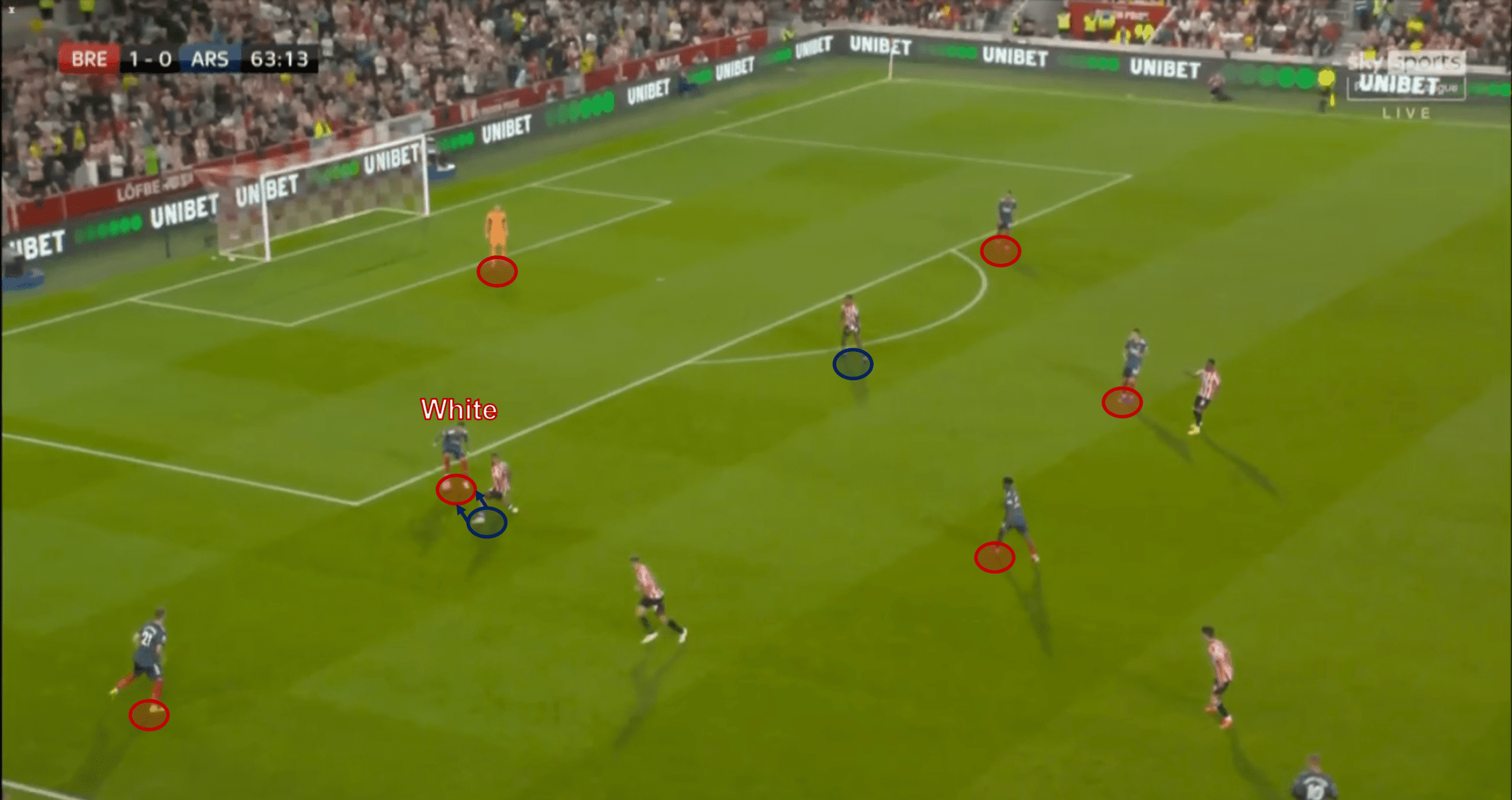
Mbeumo places White under heavy pressure here, but the centre-back has nearby options to pass to.
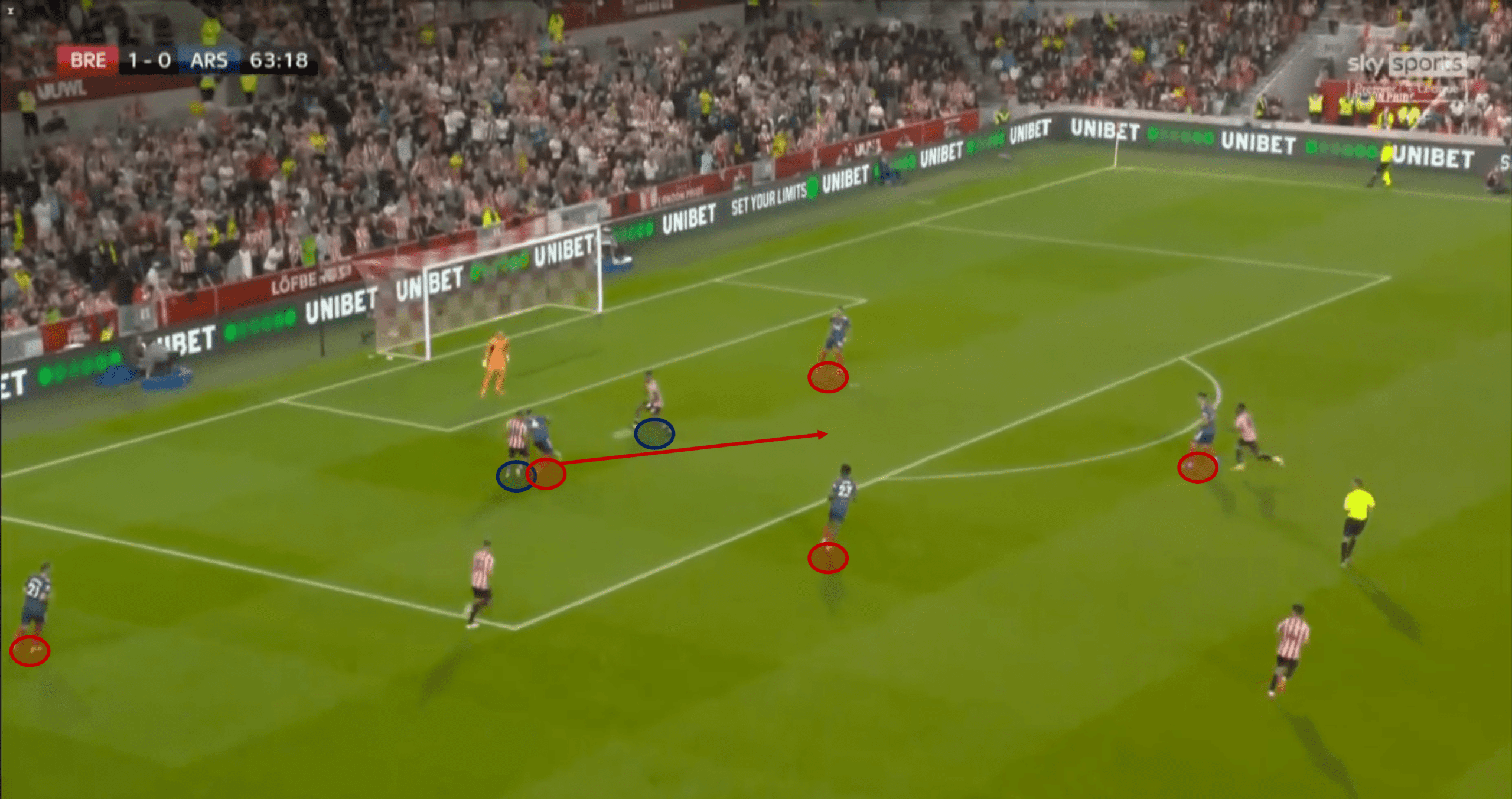
He turns back and looks to find a player further up the field, in this case it was Saka.
When speaking about Brentford’s work off the ball, it is hard not to mention Toney upfront. Upfront, I say naively, as he was all over the pitch for The Bees. In the latter stages of this match, he was found defending at left-back, tussling and tumbling for the ball, let alone the physical presence he provided Brentford in the final third when they wanted to be a bit more direct. For many, he was Brentford’s best player despite not scoring or assisting, and his work off the ball had a huge part to play in those claims.
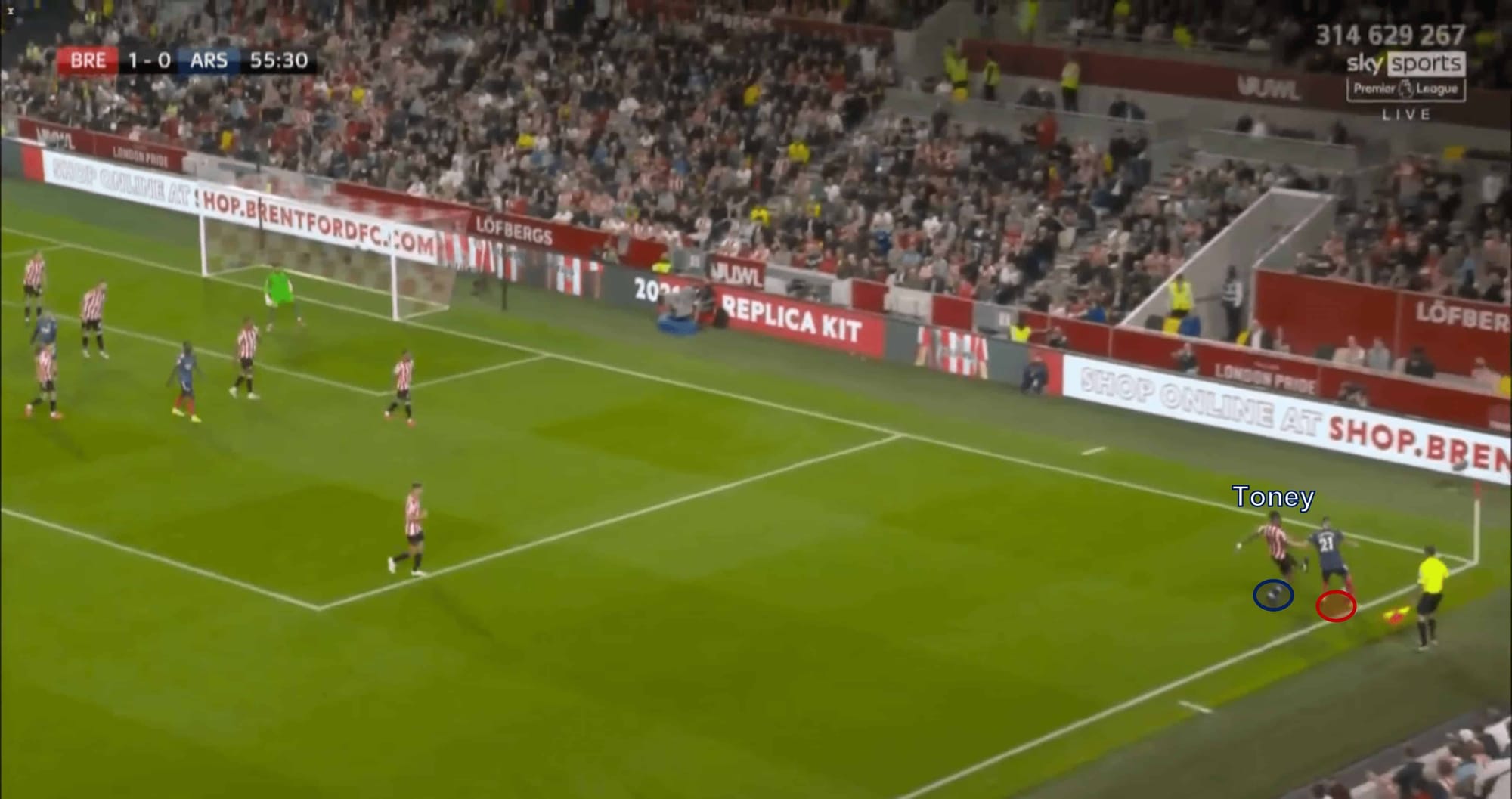
Here we can see Toney’s defensive efforts after a free-kick broke down. Work rate.
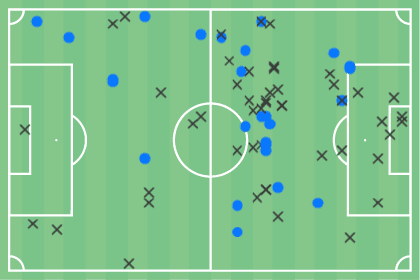
Ivan Toney’s actions in this game. All over the place.
Arsenal’s balance in midfield & attacking positives
One positive note for Arsenal was their balance in midfield for this game and the individual performances of each midfielder in the match. Starting with Lokonga as a #6, he did well to position himself in spaces where he could receive the ball and do what he likes to do best; which is to drive forward with the ball and release an attacker with his neat passing. He looked comfortable on his Premier League debut, and it should give Arsenal fans much to clamour for.
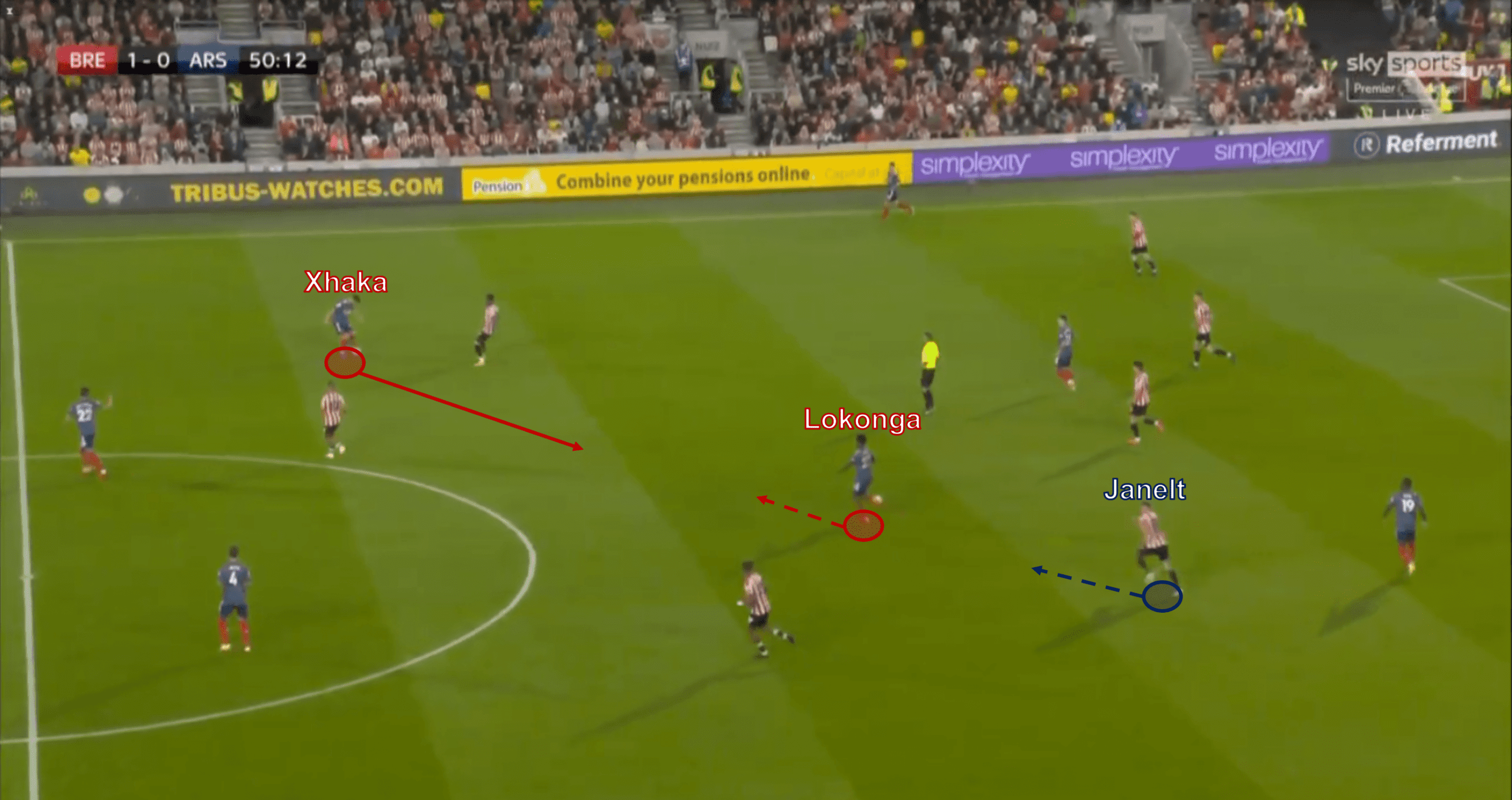
Lokonga here calls for the ball into space, fairly aware of the incoming pressure from Janelt.
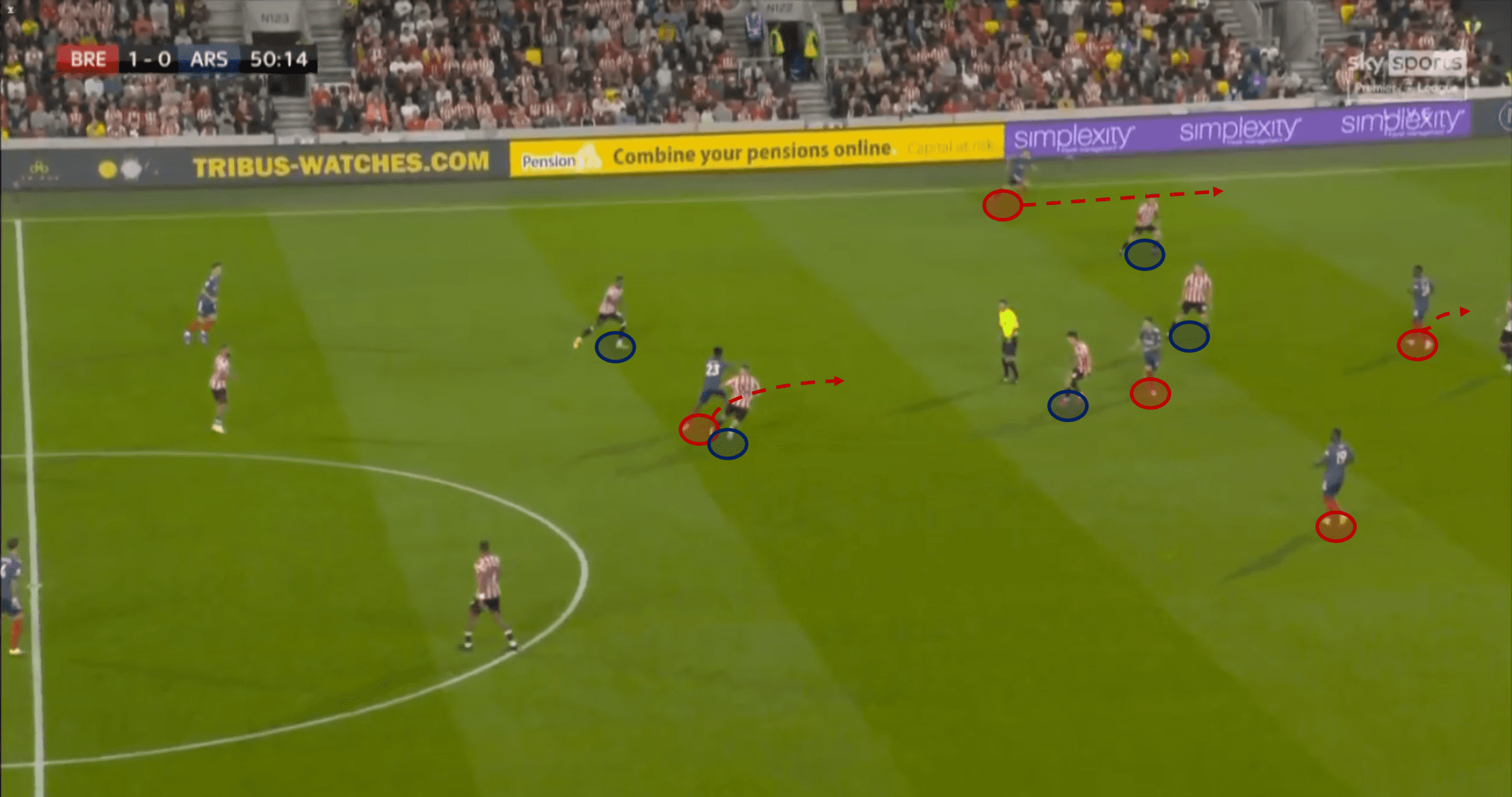
He carries the ball up the field, and on this occasion, the weight of pass lets him down, but he had the right idea.
Arsenal, when fully fit, have some nice options in midfield going forward in a season where they will have far fewer games to play than their top-eight competitors. Lokonga could just as easily partner with Thomas Partey as he did with Granit Xhaka here, or Arteta could play the aforementioned pair together too. Certainly, early signs promise that Lokonga should provide more to this Arsenal side than what Dani Ceballos ever could.
Speaking of Xhaka, he provided Arsenal with some promising moments with his passing in this game – moments which unfortunately weren’t made the most of. His long passing has long been a positive trait that Xhaka has held, and in this game, it was used to full effect. In a couple of key moments, he spotted movement into space from an Arsenal attacker in the final third which was met with an accurate long-range pass, but on both occasions, a goal was not the result.
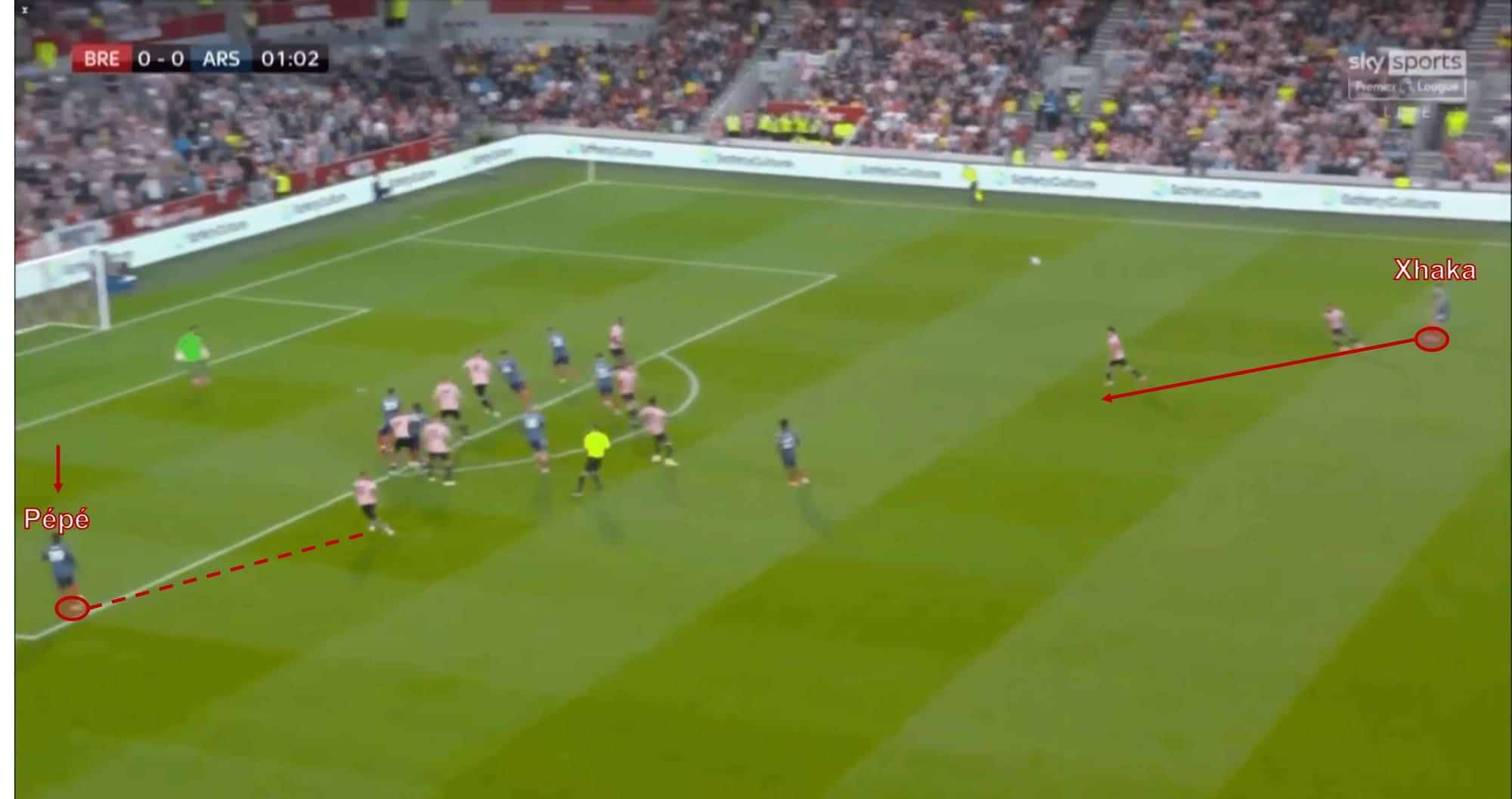
A long free-kick is played short, and Xhaka notices Pépé slip into space and finds him with an accurate long-range pass.
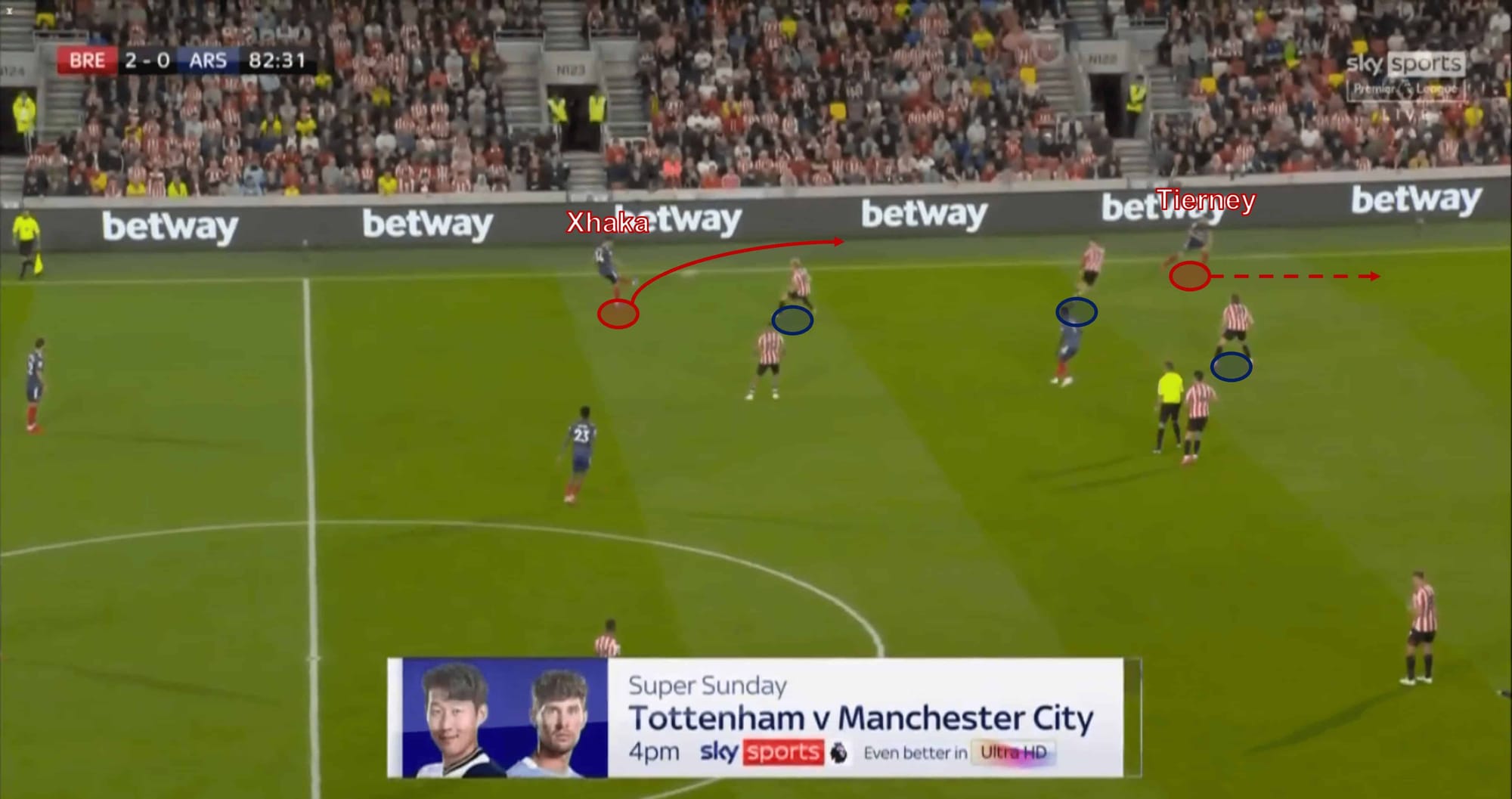
Here, Tierney makes the overlapping run which is met by Xhaka with a lobbed through ball, taking out a couple layers of Brentford defence.
The Swiss midfielder had the most progressive distance (total distance, in yards, that completed passes have travelled towards the opponent’s goal) with 494, the most progressive passes with 13 (both within the Arsenal XI), and he completed 88.9% of his long passes. While he lacks mobility and has defensive lapses, what he provides on the ball is useful and often the type of verticality that Arteta’s side desperately lacks.
Further up the field, Emile Smith Rowe also had a game to be pleased with from an Arsenal fan’s perspective. Clearly, he is still growing as a player with limited senior game time under his belt, but at a foundational level, Smith Rowe is clever in the way that he releases the ball, and in this game, it provided The Gunners with some of their best moments in front of goal. The timing of his through passes created goalscoring opportunities for Arsenal that they found difficult to create otherwise.
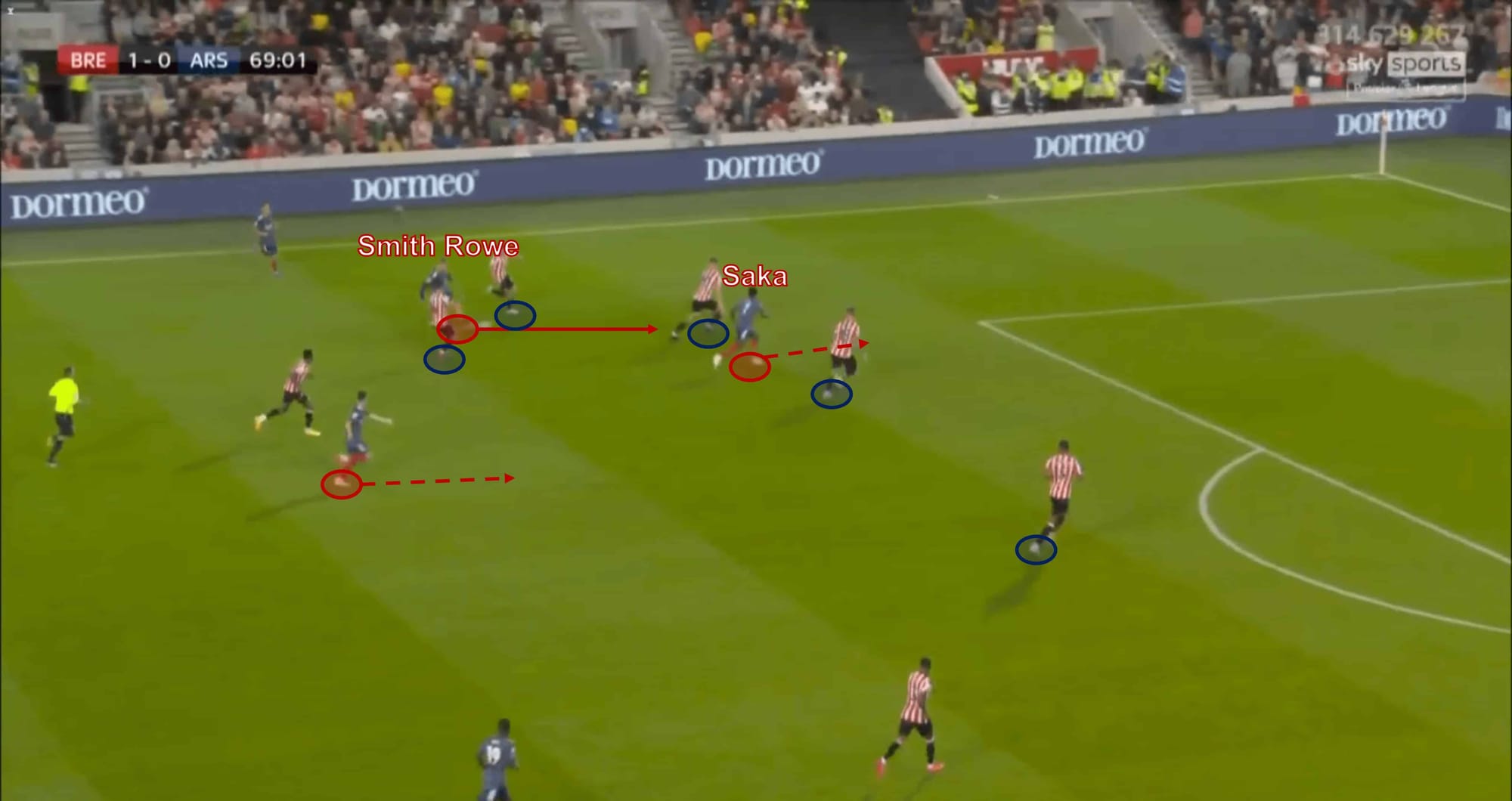
Smith Rowe here carries the ball till a point where the defenders bring their attention to him, creating space for Saka in behind.
He also combined nicely with another one of Arsenal’s bright spots; Kieran Tierney at left-back. Tierney was one of Arsenal’s only driving forces down the left flank, constantly looking for one-twos to enable him passage towards the byline or underlapping into the area. He assisted seven shots against Brentford, four more than Arsenal’s second-best creator in this game, Nicolas Pépé. That, on top of three shots, meant that the Scotsman was unlucky to be on the losing side.
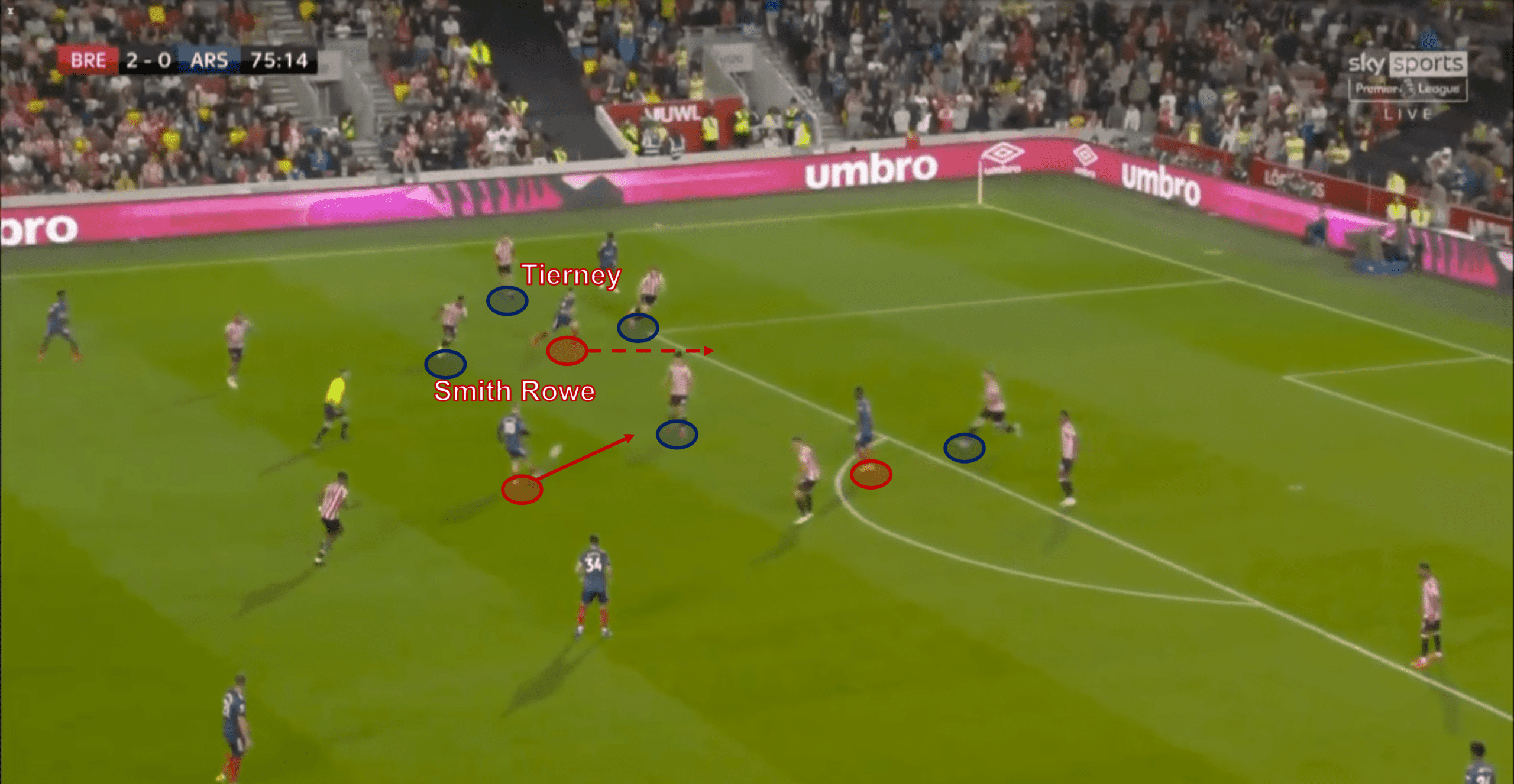
Smith Rowe plays the one-two with Tierney here, who enters the penalty area and shoots just wide.
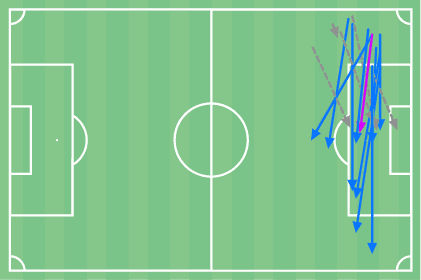
Tierney’s cross-map in this match. Incessant.
So, from an attacking perspective, it wasn’t all glum for Arsenal, but it certainly was not great. Attacking synergy was not something they possessed here, when one player held the ball in the final third, there was a serial lack of movement from anyone else to stretch the defence or ask questions of the backline. However, some of their midfield talent and Tierney’s swashbuckling displays marauding from left-back should give Arsenal fans some level of hope for the season.
What gave Brentford the edge
Brentford had everything that Arsenal did not. They had a physical presence up top in the form of Toney, they attacked with pace and vigour, and their off the ball movement in the final third didn’t resemble that of the mannequin challenge (anyone remember that?). Toney did a magnificent job of battling the Arsenal defenders and using one or two touches to create separation between himself and the defenders or play neat through passes to on running midfielders or his striker partner Mbeumo.
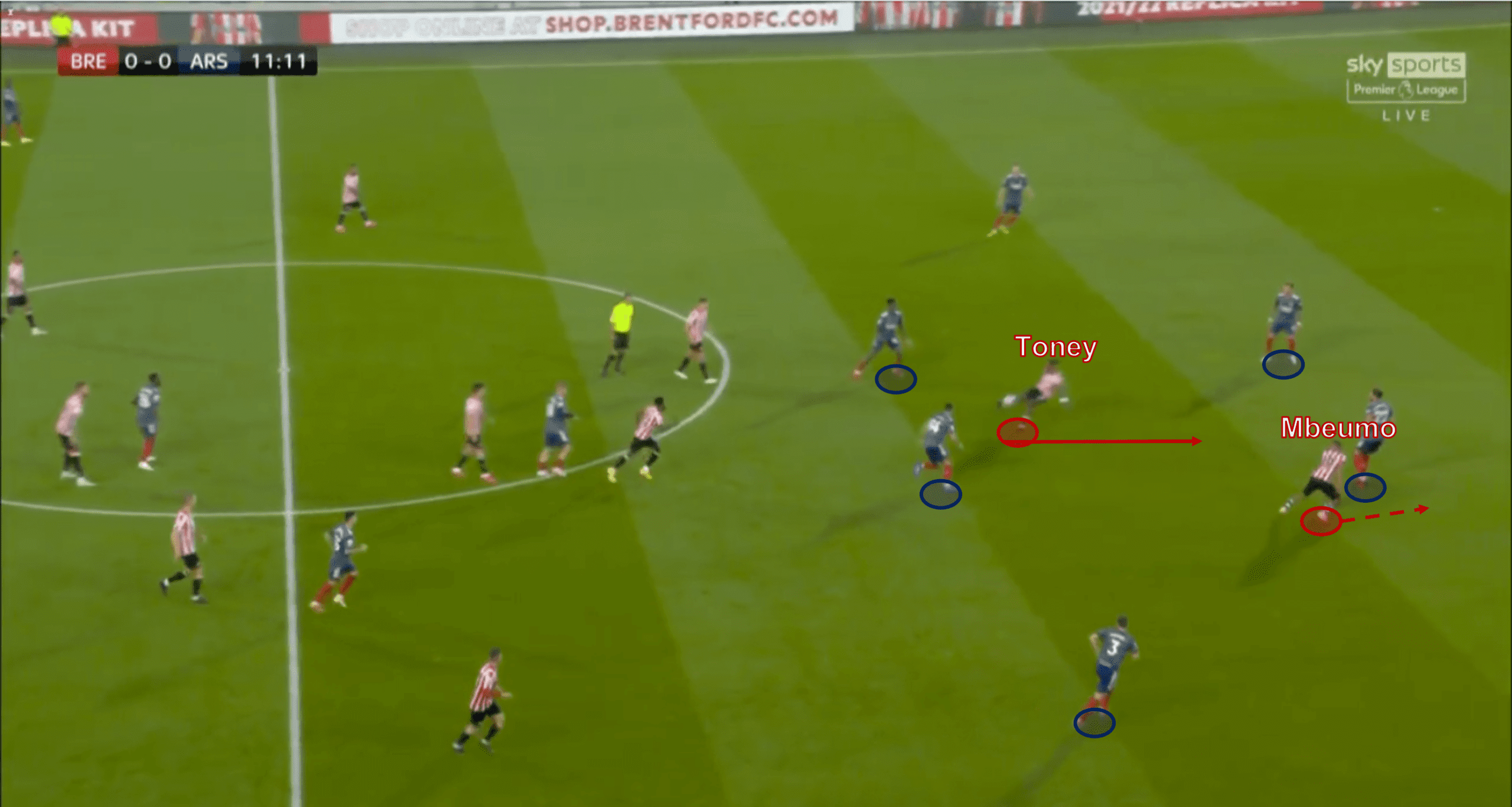
Toney drops deeper to receive the pass, and with one touch he sets Mbeumo free in behind the Arsenal defence.
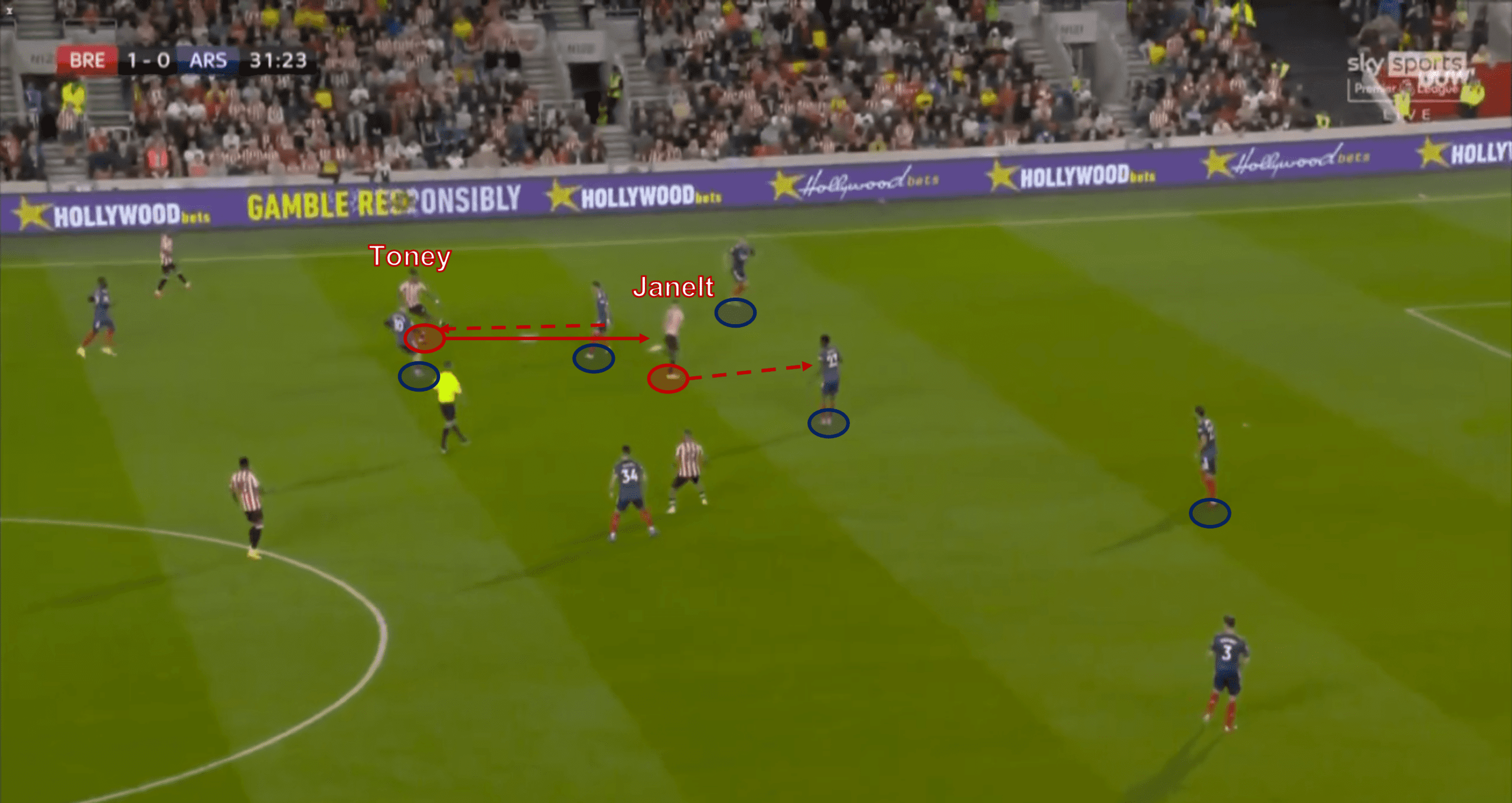
Toney collects the ball here, carries it deeper, expecting the on-running Janelt, and meets the German with a nicely placed through pass.
Toney himself won seven aerial duels, applied pressure 24 times (with a 29.2% success rate), and was a complete forward during the match. Brentford, as a collective, had far less possession of the ball, only 35% in this game, but when they attacked, it was mainly on the break, in transition, and they did so with pace and several runners. Although they played largely with a back five in this fixture, they were not afraid to throw several men forward in attacking scenarios.
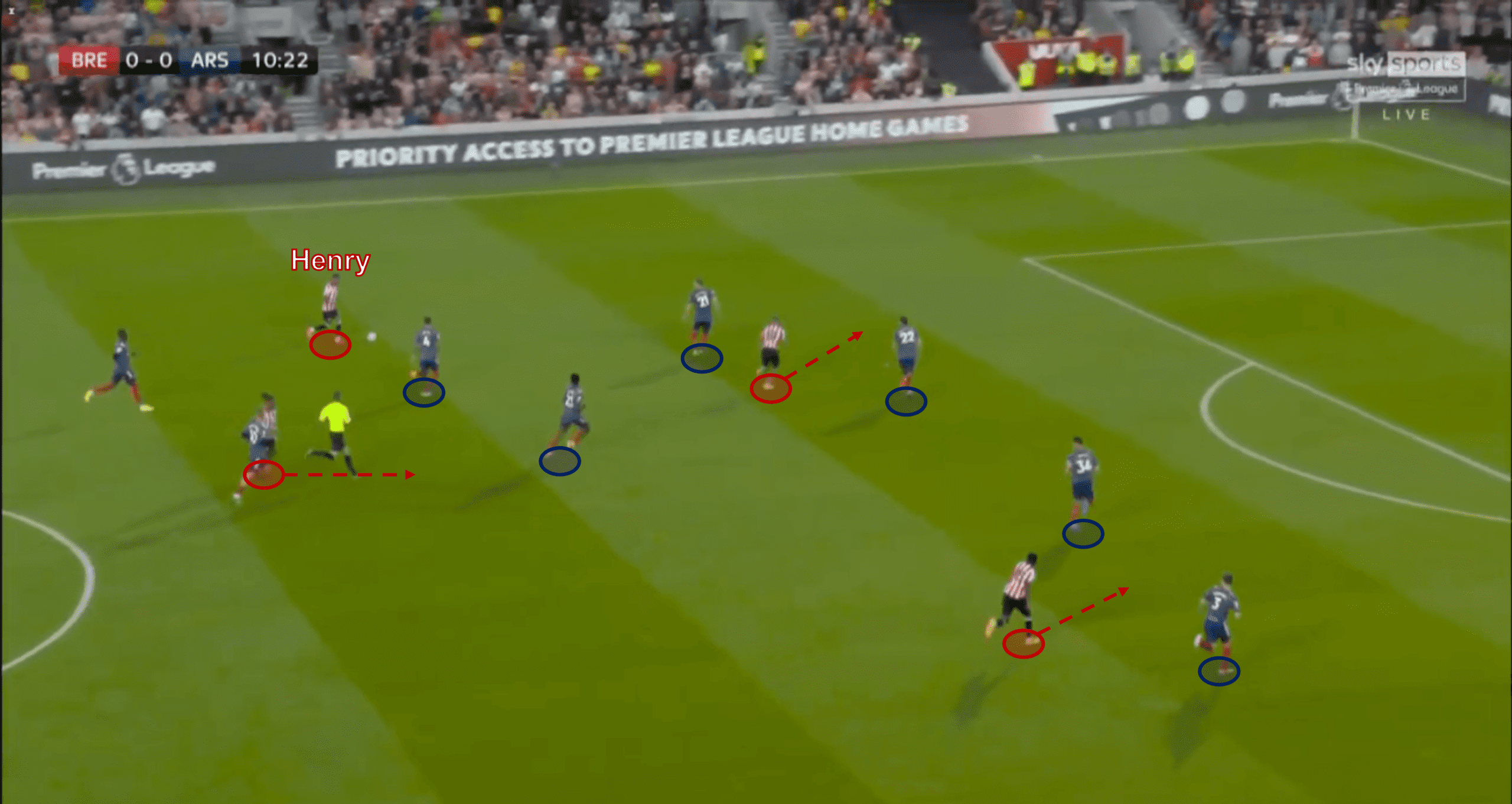
On the counter, we can see that Brentford are willing to throw several players forward to provide attacking options at pace.
Arsenal, on the other hand, looked flat in the final third, and their decision-making was poor. Pépé was especially at fault for this – his decision-making left much to be desired, he dabbled far too long on the ball, and when he went for a shot or a pass, it was easily blocked by the Brentford defenders more times than not. It was a shame for the Ivorian too – he had such a positive end to the previous campaign, and with Saka waiting on the bench, he was easily replaceable on the day.
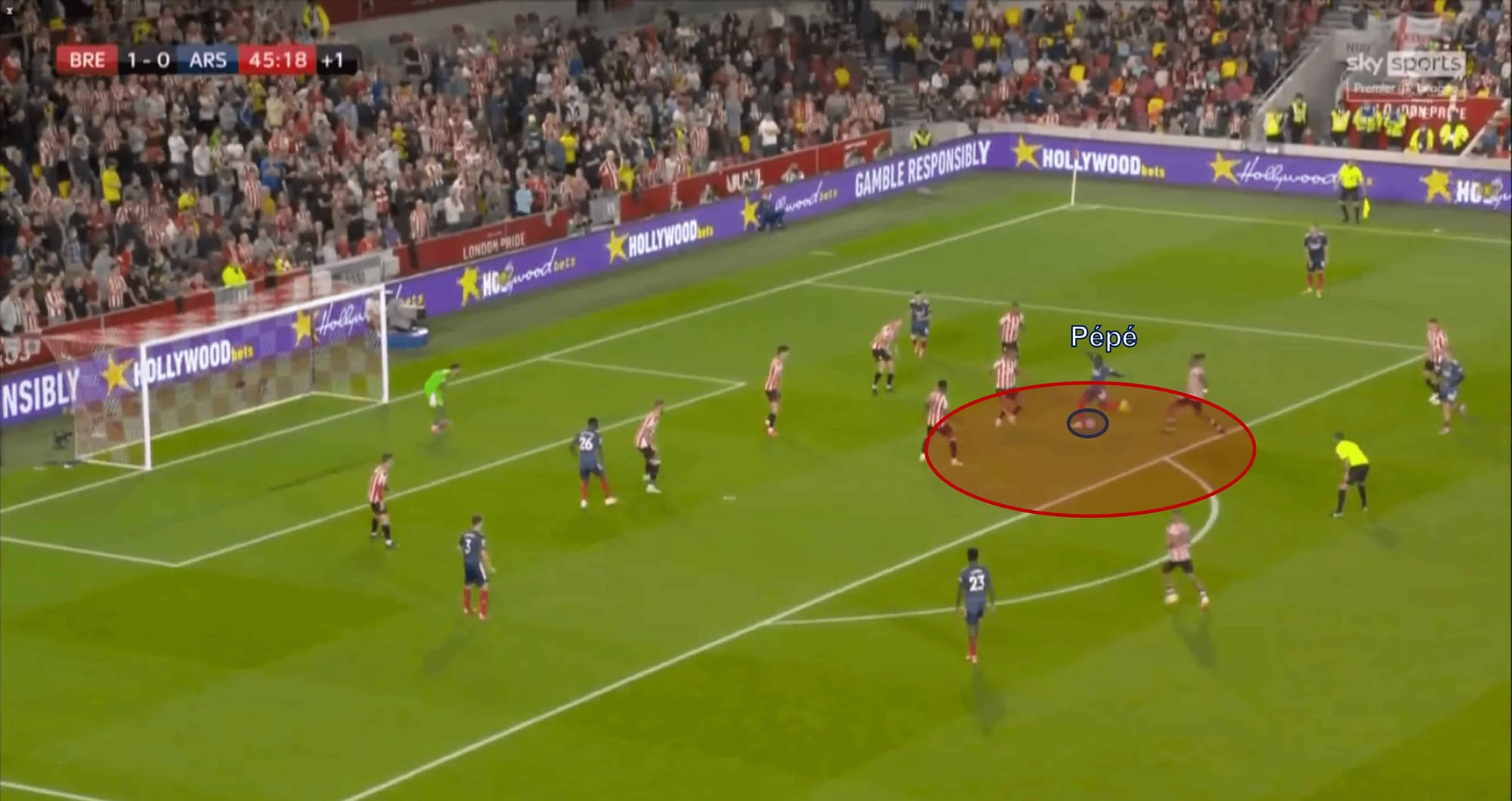
The Ivorian delayed his shot by just a moment, and this enabled Brentford to position themselves in the way of his incoming effort on goal.
It was an embarrassing contrast to Brentford’s ingenuity, pace, and verticality whenever they went forward. Nørgaard in midfield did an excellent job, alongside Janelt, of protecting that backline, and either passing to his German teammate or playing those vertical passes into the final third. Whenever they retrieved possession, their first thought was to play the ball forwards as soon as possible, to expose the momentary high line that Arsenal would use in attacking situations.
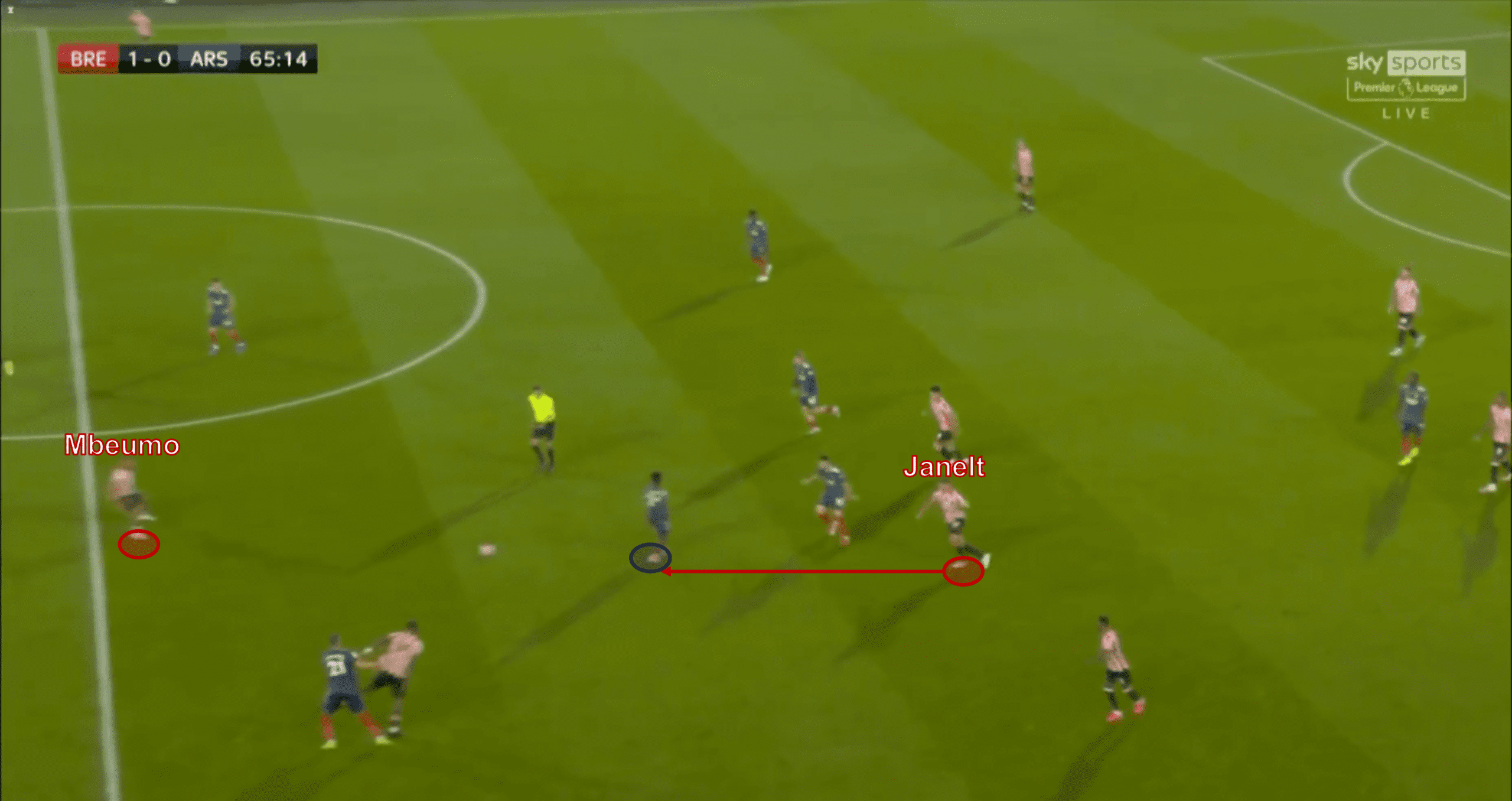
Janelt here picks up the ball in midfield and plays the vertical pass into Mbeumo’s feet.
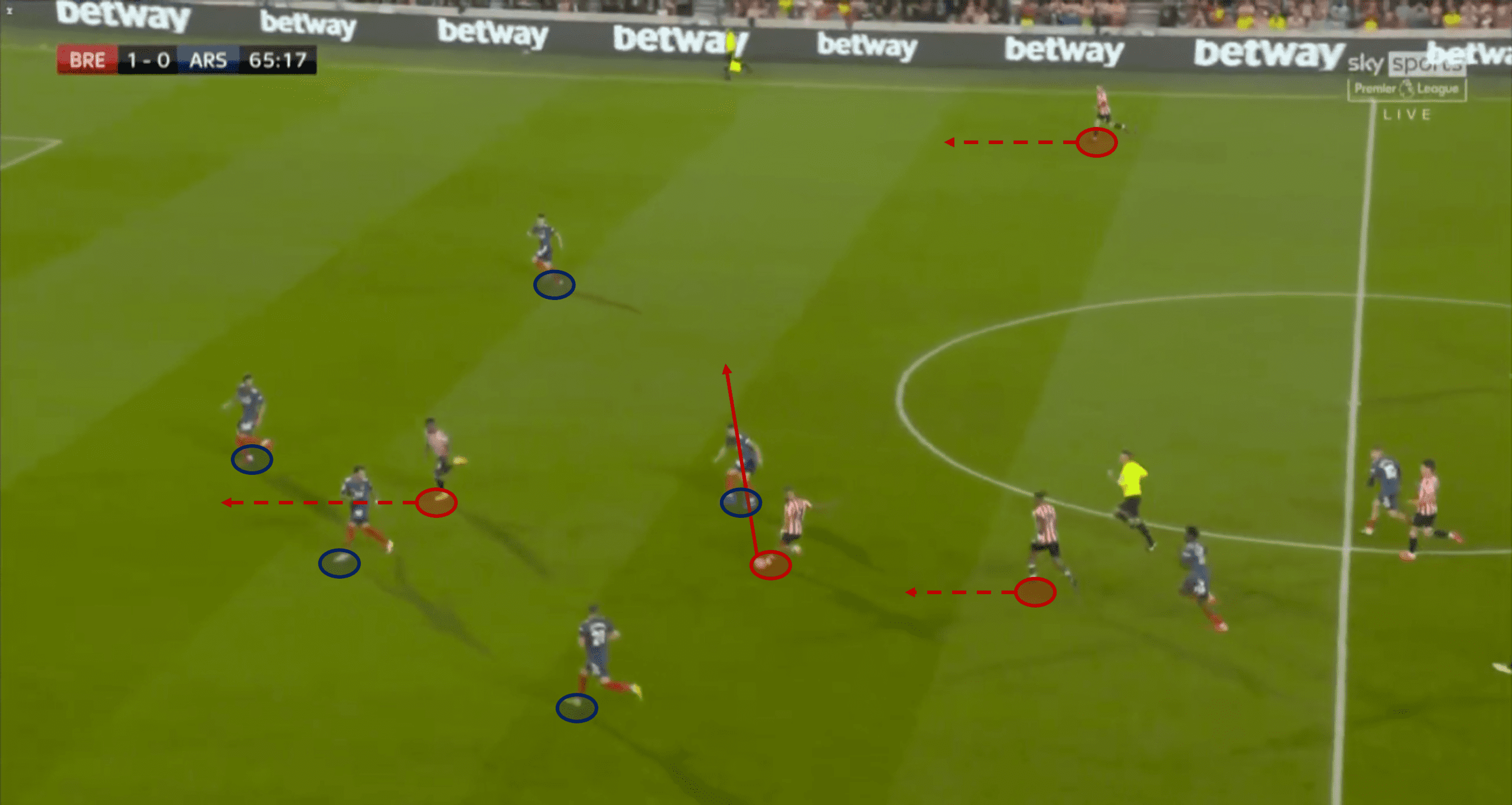
Mbeumo sprays the ball wide to Canos here, whilst other Brentford members move up the field at pace.
While Brentford were able to pull off shots from inside the area predominantly, Arsenal’s attacking play often resulted in a rotation of possession outside the area and a frustrated pot shot from one of their midfielders or defenders. This is in part due to Brentford’s good work defensively – the whole team was on board going forwards and backwards, they defended and attacked as one cohesive unit, but it was also due to Arsenal’s poor movement and lack of ingenuity on the ball.
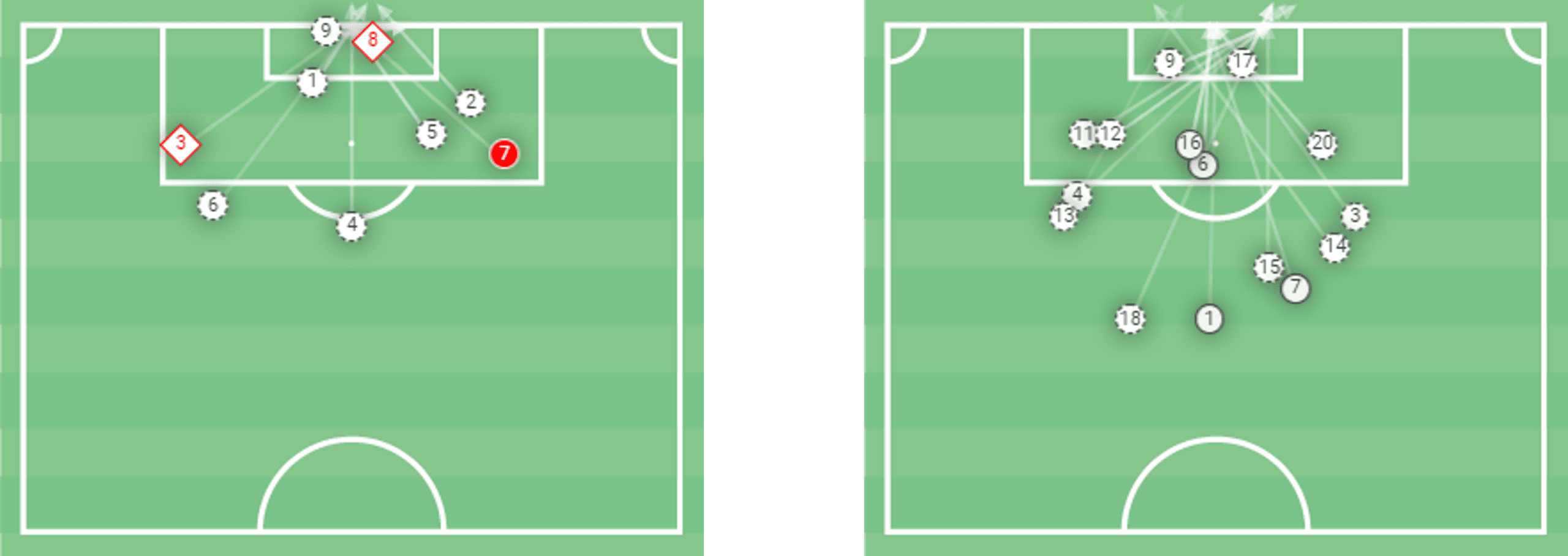
Brentford (left) and Arsenal’s (right) shot maps.
Brentford were even able to take advantage of Arsenal’s weakness in defending set-pieces. Both Pinnock and substitute Mads Bech Sørensen were able to toss long throws into the area, and it was the latter’s effort that resulted in mayhem for Arsenal, and a goal for Brentford. While White had a good game in possession, at this moment his lapse in concentration and weakness aerially directly resulted in his team conceding their second goal on his official debut.
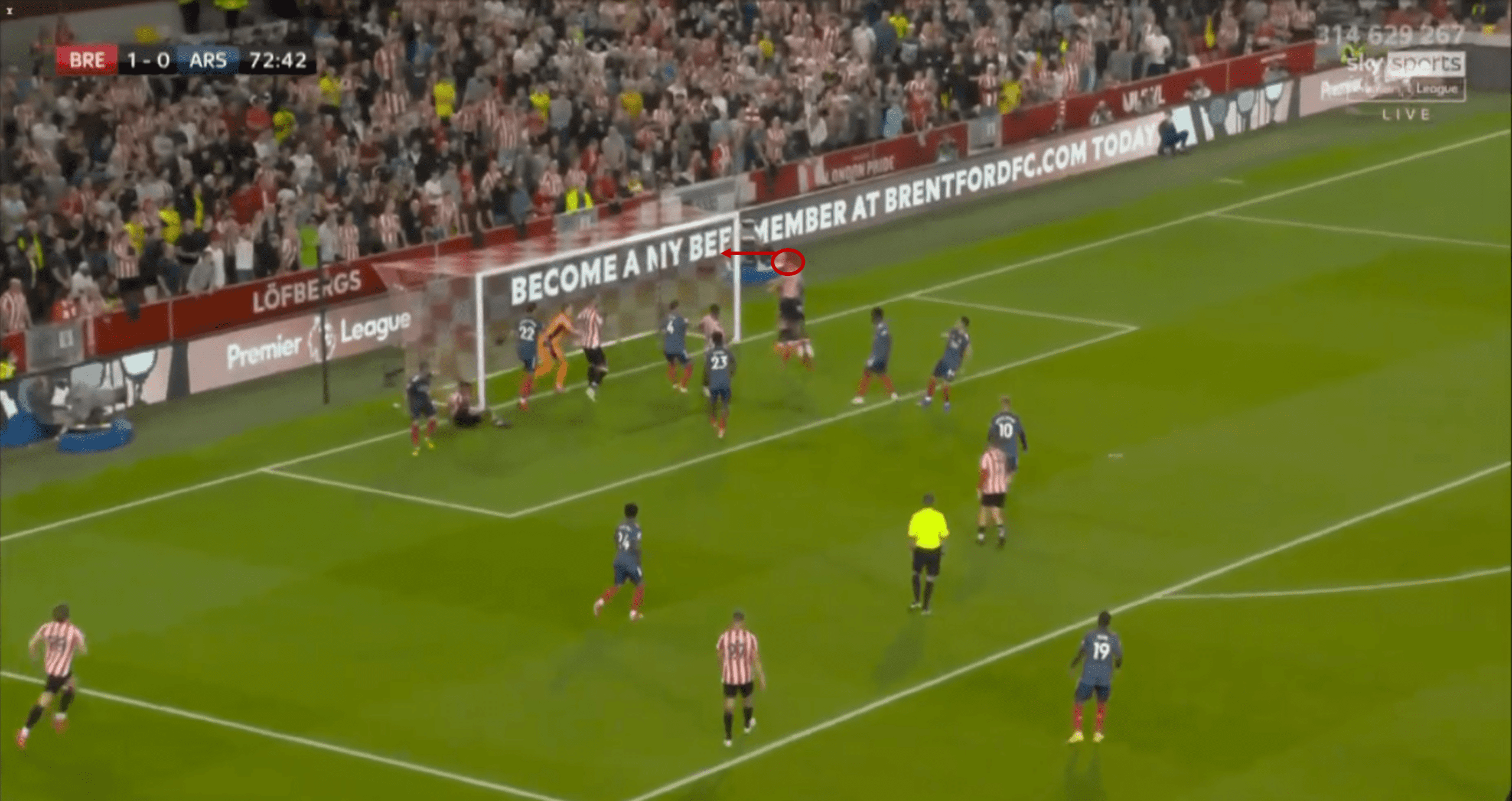
Nørgaard has plenty of space here to head home for Brentford.
Concluding thoughts
Different xG models may rate it slightly differently, but a 1.28 – 1.57 xG in favour of Arsenal seems just about fair for this game. Arsenal had a lot of shots, 22 in total, but made none of them count, nor were many of them from dangerous areas. Brentford had 8 across the match, but several of them could have been goals did they have more finishing quality.
It’s promising early signs for Thomas Frank’s Brentford, nonetheless. His team did exactly what was asked of them, and this wasn’t the only XI they could play. They are yet to integrate new signing Yoane Wissa into the first-team, and Josh Dasilva, a product of Arsenal’s Hale End academy, is yet to return fully from injury. So – exciting times ahead, then.





Comments